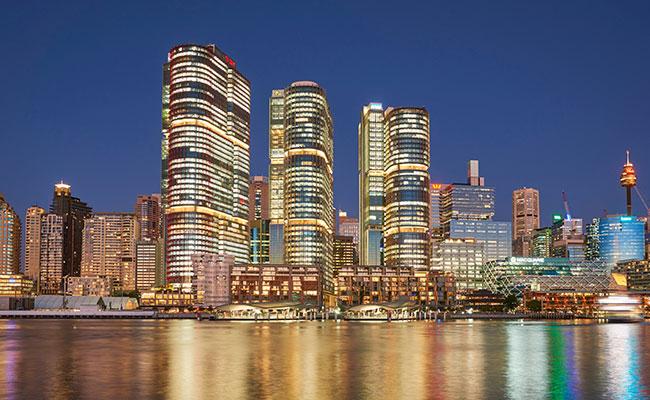Sustainable Design: Pushing the Limits of Building Performance in Sydney
Emphasizing smarter lifecycle designs to ensure our clients’ projects will thrive and endure

Increased climate variability and surging population growth are placing greater demands on limited resources such as water, energy, and physical space. Our teams are considering how buildings and infrastructure can be designed to more effectively cope with these stresses and perform well into the future. Facilities need to be built not only to operate in greater harmony with nature but also to withstand the forces it may unleash.
Tetra Tech understands the value of resiliency planning and sustainable design in addressing emerging risks associated with a changing world. We develop unique solutions to some of the toughest problems—using both cutting-edge technologies and commonsense approaches.
As conceptual frameworks, resilience and sustainability increasingly guide decisions in the planning, design, and engineering of our projects. Resiliency emphasizes robustness and the ability to recover, while sustainability considers measures of environmental impact and resource conservation. Both concepts share common end goals in contributing to society’s capacity to thrive in a meaningful way. In this Sustainable Design article series, we highlight Tetra Tech projects that represent some of the industry’s very best examples of resiliency planning and sustainable design.
Sustainable Design
Where resilience asks how to build infrastructure that can withstand a changing environment, sustainability considers how facilities can be designed to integrate with their surroundings—minimizing environmental impacts, waste generation, and energy consumption. Tetra Tech’s growing global sustainable infrastructure practice is using innovative design approaches to control temperature, reduce energy costs, and conserve water.
Pushing the limits of building performance in Sydney
Innovations built into Australia’s International Towers Sydney (ITS) exemplify how sustainable designs can minimize environmental impacts and contribute to energy efficiency.
ITS, developed by Lendlease in the Barangaroo South precinct, is part of Sydney’s largest urban renewal project. The three towers provide a combined 270,000 square meters of A-grade office space. The buildings incorporate a diverse range of innovative design and engineering features that collectively push the development to the peak of sustainable performance.
Lendlease retained Australia-based Norman Disney & Young, A Tetra Tech Company, to provide mechanical, electrical, communications, security, and building information modeling design for the three towers.
Our team undertook a collaborative process with Lendlease Applied Insight to design an air conditioning system serving all three towers. The unique, highly sophisticated solution incorporates passive chilled beams in the central zones of the towers and active chilled beams in perimeter areas controlled by a variable air volume system. To optimize system performance, the team focused on the building facades, collaborating with the project architect and Lendlease Applied Insight on design strategies to limit the maximum load on any given facade.
The design process for the facades was representative of how the team approached every solution, according to Richard Pickering, project manager in our Sydney office. “In making the building as efficient and sustainable as possible, we looked at every element in great detail,” he said. “We optimized the technical aspects of the systems, the supply air, the chilled water, how energy was transferred around the building, and the use of heat recovery systems to ensure we were achieving the highest performance.”
Another major design consideration for the ITS project was to construct the buildings with the future in mind. “As building services engineers, our responsibility is to incorporate elements into the design that are truly sustainable and will contribute to energy efficiency and reducing our carbon footprint; but part of that also relates to how the systems and the building itself can be designed with adaptability for future flexibility and to address possible climate impacts,” Richard said.
One of ITS’s “future-proof” designs includes a single integrated communications network for all the buildings’ systems that uses open communication protocols to provide capacity for additional systems and future technologies. Moreover, while the building was initially commissioned for ventilation for one person every 10 square meters, the actual handling equipment and risers were sized to handle one person per 8 square meters, allowing for higher population densities in the future.
“To have a building that is scalable and equipment with the flexibility to adapt to continue operating at peak efficiency is probably one of the most important factors to the sustainability of the building and its ability to remain relevant in years to come,” Richard said.
Our team has subsequently designed sustainable interiors for ITS tenants, including some of Australia’s largest publicly listed companies. Our designs provide modern, flexible, technologically enhanced work spaces that have led to reduced energy requirements and improved staff engagement.
A commitment to our future
A city is the sum of its parts—buildings, communities, coastlines—and efforts to enhance long-term resilience and sustainability must reach across all of them. Tetra Tech’s community resiliency specialists and global sustainable infrastructure teams are demonstrating what can be achieved through collaboration, creativity, and an unwavering dedication to the highest principles in planning, design, and engineering. By leading in projects that advance resiliency and sustainability, we can continue to deliver the most effective solutions to our clients and help ensure a vibrant and enduring future.

